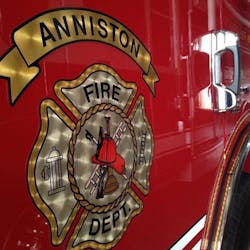Dozens of AL Firefighters, Medics Receive Coronavirus Training
By Ben Nunnally
Source The Anniston Star, Ala.
Editor's note: Find Firehouse.com's complete coverage of the COVID-19 pandemic here.
Dozens of medics and firefighters filled a classroom at an Anniston Fire Department training center Tuesday, part of an effort to prepare more than 850 local first responders for contact with the coronavirus COVID-19.
Though the training includes some extremely specific knowledge—how to use personal protective equipment like face masks and full-body jumpsuits or line an ambulance in plastic — other parts echo the warnings and guidelines shared by the Centers for Disease Control and Prevention and the state Department of Public Health for weeks now: Always wash your hands.
RELATED:
- NY Responders Ask Callers for COVID-19 Warnings
- Chicago FD Paramedic Tests Positive for COVID-19
- Coronavirus Threatens to Thin FF Ranks in Los Angeles Area
- CT Chiefs: FFs, Police Lack Protective Gear for Coronavirus
- Pittsburgh FFs Won't be Notified of Coronavirus Exposure
- New Procedures Help Firefighters Tackle Coronavirus
An instructor at the head of the classroom showed how to remove full-body protection, from his bright-yellow, plastic jumpsuit down to his face mask and two pairs of sanitary gloves. After each item was remove —“doffed,” in the lingo of the emergency professional —the instructor sanitized his gloves, and finally his hands, easily sailing into the range of 10 stops at the approved sanitizer dispenser. The stringent cleaning routine keeps contaminants from surviving on the disposable equipment and spreading, the instructor said.
Chris Collins, Anniston’s fire chief, said the training will ultimately keep coronavirus droplets off of first responders, their vehicles and their gear.
“We’re not going to have any transmission away from the site,” Collins told reporters in the lobby of the now-completed training center. “We leave all the infection on the scene; that’s the goal.”
Collins said there are certain criteria that responders will listen for on dispatched calls to try to predict when protective equipment is necessary, the same criteria used by the CDC as a standard for testing. That criteria includes patients with fevers and respiratory issues like labored breathing, coughing and shortness of breath.
CORONAVIRUS RESOURCES:
- International Association of Fire Fighters Tool Kit
- International Association of Fire Chiefs Resource Page
- EPA List of Disinfectants to Use Against COVID-19
Jackson Hodges, the city of Anniston’s public information officer, was with trainees the day before, he said, and again Tuesday.
“As much as we need to make sure the public stays safe, we’ve got to make sure our first responders are staying safe, too,” Hodges said.
The city and Fire Department had stressed keeping its emergency personnel clear of the virus to avoid any disruptions to service, he said. Collins, he said, had been especially vigilant about safety, even before the training classes began.
“He’s going about this as if these were his kids going out there,” Hodges said.
Michael Barton, Calhoun County Emergency Management Agency director, also encouraged keeping first responders safe, by limiting exposure in hospitals.
“If someone thinks they have symptoms, they should consult with their primary physician before they take any action,” Barton said between class sessions. “If they don’t have a primary physician, call the hospital first and wait for instructions about where they can go to talk to a doctor about criteria to be tested.”
The second phase of training for the day involved working in plastic-lined ambulance interiors. Anniston EMS had a unit in the big warehouse area behind the classrooms already lined and waiting for a class to arrive.
Sammi Stephens, director of Anniston EMS, said it took about three hours to line the interior of the vehicle. The lining will stay in the ambulance and be disinfected with a fogger spraying a bleach mixture as needed between calls.
“It’s ready to go in a maximum of 10 minutes,” Stephens said.
Meanwhile, EMS staff are having their temperature checked at the start of each shift, Stephens said, and Hodges added that Anniston Fire Department follows the same procedure.
Collins said that from the national perspective, the coronavirus is a unique challenge.
“But from an emergency response perspective, we train for chaos,” Collins said. “We deal with chaos on a daily basis. This is a new type of chaos and our training and preparations are evolving with that.”
Collins recommended that area residents visit calhounema.org, the home site of the Calhoun County Infectious Disease Task Force, for updates as local response to COVID-19 continues to develop.
———
©2020 The Anniston Star (Anniston, Ala.)
Visit The Anniston Star (Anniston, Ala.) at www.annistonstar.com
Distributed by Tribune Content Agency, LLC.






